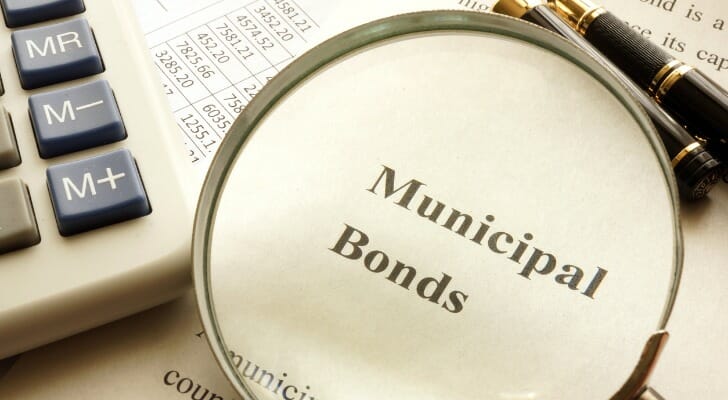 Municipal bonds (or “munis”) are a fixture among income-investing portfolios. Investors who want a higher returns can invest in high yield municipal bonds. These bonds pay more than investment-grade counterparts, but are risky. There’s a realistic chance you’ll never get that money back. Here’s how they work.
Municipal bonds (or “munis”) are a fixture among income-investing portfolios. Investors who want a higher returns can invest in high yield municipal bonds. These bonds pay more than investment-grade counterparts, but are risky. There’s a realistic chance you’ll never get that money back. Here’s how they work.
High Yield Municipal Bonds Defined
A high yield municipal bond is issued by a government. It is either not rated by the major credit rating agencies or has been given a rating below investment grade. Ratings below BBB/Baa3 are generally considered not investment grade. While private entities can also issue high yield bonds, only state or local governments can issue high yield municipal bonds.
A government generally issues high yield bonds to pay for projects with undefined or uncertain revenue. Communities will typically fund works like highways and schools with traditional bonds. However, they reserve high yield instruments for more speculative projects.
As a result, high yield bonds generally produce considerably higher returns than investment grade bonds. For example, a modest selection of representative funds posted single-year returns in 2019 of between 6.5 % and 11.26%. Across the board, these instruments averaged a return of 4.9% in 2018 compared to an average rate of return of 1.49% for investment grade municipal bonds.
Yet this return comes at a cost. High yield bonds also come with considerably greater risk than investment grade instruments. Default and non-payment is a risk with any instrument, even Treasury bonds, with most investment grade debt security this risk is trivial. When investing in high yield municipal bonds the risk increases. Research from Moody’s has found that as many as 6.5% of all high yield municipal bonds fail.
High Yield Municipal Bonds vs. Junk Bonds
 When corporations issue high yield bonds rated below investment grade, they are typically known as “junk bonds.” Municipal bonds are not considered junk bonds, chiefly because they are much more stable than corporate bonds.
When corporations issue high yield bonds rated below investment grade, they are typically known as “junk bonds.” Municipal bonds are not considered junk bonds, chiefly because they are much more stable than corporate bonds.
Corporate junk bonds have approximately a 30% default rate. They also tend to pay higher coupon rates than municipal bonds. Meanwhile, they do not offer the tax-advantaged status of the latter product. While both are high yield, low-grade instruments, it is important not to confuse corporate junk bonds with high yield municipal bonds.
High Yield Municipal Bonds vs. Investment Grade
Investment grade municipal bonds are government issued debt that receives a credit agency rating of BBB/Baa3 or above. As a result they tend to pay considerably lower coupon rates than high yield bonds, which need to compensate investors for the risk of loss.
The two types of securities have a few additional key points of comparison:
Tax Free
Returns on both high yield and investment grade municipal bonds are exempt from federal taxes. In some cases they are also exempt from state and local taxes as well.
Risk Rate
While investment grade municipal bonds have a low rate of default, less than 1%, high yield municipal bonds have a high one. At 6.5%, there is a meaningful chance that this investment will default.
Risk Profile
Because high yield bonds generally fund more speculative projects they are also more vulnerable to economic performance than traditional bonds. A bad economy can cause the government-funded underlying asset to perform poorly. Also, it could cause construction to fall through altogether, leading the bond to also potentially fail. This is a different risk profile from an investment grade municipal bond. Such bonds rarely move with economic factors.
Secondary Market
Most bonds are traded on the secondary market. Since high yield municipal bonds are a niche product, the market for this security is small. That makes them both semi-illiquid, as it is harder to sell this security in a smaller market. Also, it is more volatile, as prices ripple quickly through small markets.
Securities
If you are investing in an individual high yield bond it is important to look at what securities the underlying project has generated. Many construction-based bonds, for example, will secure the underlying funds with a lien on the land. Also, they may pledge to share the project’s future revenue or cover losses with increased taxes. Understanding this will significantly alter the risk profile of your bond.
High Yield Municipal Bond Investing
Individual investors will most likely invest in high yield municipal bonds through a mutual fund or an ETF. These bundled funds allow you to access the bond market without the specialized skill that it takes to trade those securities directly.
Investing in high yield municipal funds can provide a few benefits to the average investor. Among others, they include:
Income Generation
A high yield municipal bond is often a strong choice for income investors. The coupon rate for this asset class is one of (if not the) highest among fixed income securities.
Diversification
High yield bonds respond to different economic pressures than investment grade bonds. The price of this asset class responds to economic pressure more easily than higher-grade bonds do. But, at the same time, its high rate of return makes it much less susceptible to depreciation or interest rate risk. This means that the high yield section of your portfolio will have a different risk profile than the investment grade bond segment. However, it will share some of its risk profile with your equities).
Low Risk
This asset class has a higher risk of default than investment grade bonds. However, it is still a safer bet than many equities and a far safer bet than corporate junk bonds. This can put high yield municipal bonds in a sweet spot of risk/reward for many investors.
The Bottom Line
It is important to consider that high yield bonds do come with significant risks. They have a realistic risk of default. Meanwhile, they’re also vulnerable. to economic conditions.
That means bonds in this asset class are far less secure than debt securities typically are. Investors take a meaningful risk on this product, and it’s important to remember that.
Bond Tips

- If you aren’t sure where bonds fit in your portfolio, consider consulting a financial advisor. Finding the right financial advisor that fits your needs doesn’t have to be hard. SmartAsset’s free tool matches you with financial advisors in your area in 5 minutes. If you’re ready to be matched with local advisors that will help you achieve your financial goals, get started now.
- Investing in the bond market can provide your portfolio with a stable anchor to help offset your more speculative assets. You can find out where to start in SmartAsset’s guide to the bond investing. Meanwhile, high yield corporate bonds are just one type of bond. It’s important to understand the other types so you can know your options before you start investing. Of course, maybe you’d just like a better understanding of what a bond is.
Photo credit: ©iStock.com/Maximusnd, ©iStock.com/designer491, ©iStock.com/AleksandarGeorgiev